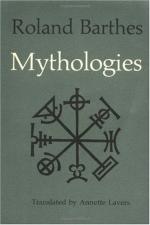|
This section contains 602 words (approx. 2 pages at 400 words per page) |

|
Mythologies Summary & Study Guide Description
Mythologies Summary & Study Guide includes comprehensive information and analysis to help you understand the book. This study guide contains the following sections:
This detailed literature summary also contains Topics for Discussion and a Free Quiz on Mythologies by Roland Barthes.
This short but intellectually dense book examines contemporary mythology from two distinct perspectives. Specific manifestations of the relationship between myth and popular culture are explored in the series of short essays making up Section 1. Section 2 consists of a lengthy essay examining and defining, from the author's personal perspective, the general ways in which myths function and are defined.
Mythologies is written in two sections. The first consists of a series of essays on myths and the use of the mythic language associated with a diverse range of images in popular culture. In an introduction, the author writes that these essays were written, one a month, over a period of approximately two years. He also writes that the essays grew out of "a feeling of impatience at the sight of the 'naturalness' with which newspapers, art and common-sense constantly dress up a reality ... undoubtedly determined by history." This statement contains a key thematic element of both Section 1 and Section 2—the belief that the creation and understanding of myth is a function of human experience in particular times, places, and circumstances.
The essays in Section 1 examine a wide range of examples of such experiences, albeit a range limited to experiences in France (the country in which the author resided) in the 1950's (the time at which the book was written). Tourism, cooking, striptease, advertising, literature, film, many more - all, in the author's perspective, manifest mythic language, and all manifest the particular purpose of myth as defined by the author in the second half of the book - to manipulate public perception and experience.
Section 2 is subtitled Myth Today, and consists of a complex, detailed, theoretical examination of the construction and function of myth. The author begins his essay with the statement that myth is a form of language/speech, and goes on to de-construct mythic language into its various components. The arguments here are densely intellectual, defining the development of myth as a rational exercise in delineating perception. Without actually using the word, he presents the theory that myth is a kind of culturally sanctioned propaganda, using images with universal resonances and commonly understood meanings to tell individuals what and how to feel about being human.
Central to the theories developed in both Sections 1 and 2 is the idea that the need for this imposed, propaganda-like experience of culture, as well as society's perception of it, are defined by the bourgeoisie, or working/consumer class. The examples in Section 1 of how mythic language is used are all taken from bourgeoisie popular culture, while the theories developed in Section 2 are founded upon the premise that the working class has no interest in, and is indeed threatened by, any knowledge of experience beyond their own concerns. In essence, the author seems to be proposing that myth, in contemporary culture as in the past, is simultaneously a simplified explanation for human experience and a facade protecting everyday humanity from the dark, despairing, existential depths of that experience.
There is, the author acknowledges in the final section of Myth Today, a paradox in this idea of "myth as mask." He writes that myth, in these terms, is simultaneously necessary and dangerous—necessary because it keeps humanity from full awareness of its darker side by offering palatable explanations, dangerous because it keeps humanity from full consciousness of the dangers associated with that darker side. He writes in conclusion that a reconciliation between reality and humanity's need to protect itself from reality must be sought, implying that myth has the potential, if not the actual, capacity to act as the medium for that reconciliation.
Read more from the Study Guide
|
This section contains 602 words (approx. 2 pages at 400 words per page) |

|



